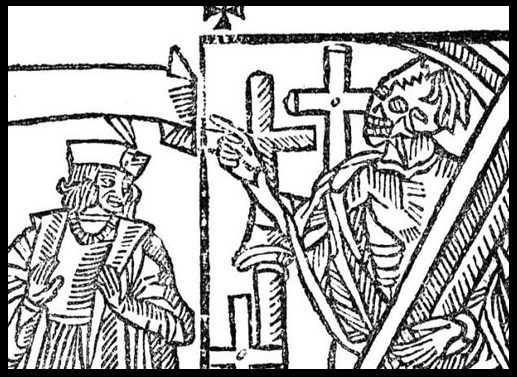
Everybody by Branden Jacobs-Jenkins
directed by KT Turner
dramaturgy by Ariana Burns
(Section of frontispiece from edition of Everyman published by John Skot c. 1530.)
Limited materials have survived to tell us about morality plays of this period. Here is Dorothy Wertz’s description of the extant materials:
What survives is (1) texts, sometimes in several versions of varying corruption; (2) occasional stage diagrams or instructions for costuming; (3) writings of reformist clergy who disliked theater; (4) account books of the guilds, listing expenditures and properties for performances (p 443).
These materials give a sense of what stage, costumes, and props were used in the sixteenth century for the morality plays as well as performance style. Some of the details were surmised from plays other than Everyman.
The religious plays were staged on holidays as an upbeat part of the festivities (Twycross, “Genres,” p 258). One of the several things that makes Everyman unique is its seriousness (Tydemann, p 18).
When presenting the morality plays, the producers were not concerned with photorealism in their sets. Tydemann wrote that they relied on improvisation and imagination (p 171). He also observed that they created “small-scale illusions of reality.” He noted examples of a realistic staging of Cain murdering Abel or “blood from the side of the stricken Christ appears to spurt out and cure the blind Centurion” or the “torments of the Savior.” He continued that he didn’t believe the elements clashed for the audience to ruin the experience (Tydemann, p 173).
This juxtaposition of the real and the unreal also served the edification goal of the plays. It created a shared lasting and immediate memory of the event:
...though the actor is not Christ and the audience are aware of this, the presence of another human body viscerally enacting the torments of the Saviour, transforms the story and its relevance into a real, felt presence making it even more immediate than imagining the same scene, the impact of which could be felt directly by the audience. Carole Wright, p 32
During the Middle Ages, there were few site-specific performance venues to stage drama. And when it came time to stage the morality plays, the producers had to use what was available (Tydemann, p 163). Plays could have scenes constructed on a series of wagons that moved or the audience walked from one to the other, build at an outdoor location, an inn yard, or be performed indoors (Tydemann, p 33, 78, 104). Any of these locations might be what we think of as multi-use sites:
We have to remember that they did not have distinct buildings called theatres dedicated solely to the performance of drama. The nearest to these were the ‘playing places’ of East Anglia and elsewhere, where the major place-and-scaffold plays were enacted: but even they, once the theatrical game was over, could revert to venues for football or wrestling. Meg Twycross, “Genres,” p 259.
Medieval acting was presentational. The characters they portrayed were not complex and the roles rarely demand nuance (Tydemann, p 181). Twycross noted that the plays employed many non-naturaluralistic techniques in performance: breaking the fourth wall, masks, allegory, and symbolic action (“Masks,” p 233). “All theatre is illusion, but this draws attention to the fact” (“Genres,” p 258).
And finally, moralities were not fully masked presentations. Instead of concealing the wearer, they commented on their moral state. This found its roots in the cultural belief that state of the soul was reflected on the body like corruption or ambivalence (“Masks,” p 234, 277). And while they are not described as wearing a mask, Twycross made a costuming note on Death in Everyman:
The text gives no guidance about Death’s appearance, alluding only to his spear; but the woodcut prefacing the printed editions shows a wholly traditional skeletal Death, suggesting that this was how he was envisaged by readers, and most probably also audiences of the play. “Masks,” p 250.
Twycross, Meg. “Codes and Genres.” Companion to Medieval English Literature and Culture c.1350–c.1500 Edited by Peter Brown. Medieval English Theatre. Blackwell Publishing Ltd. 2007.
Twycross, Meg, and Sarah Carpenter. Masks and Masking in Medieval and Early Tudor England, Taylor & Francis Group, 2002. ProQuest Ebook Central, ebookcentral.proquest.com/lib/uidaho/ detail.action ?docID=4817054.
Twycross, Meg. “The Theatre.” The Blackwell Companion to the Bible and Culture. Edited by Sawyer, John F. A. Blackwell Publishing Ltd. 2006.
Tydemann, W. English Medieval Theatre. 1400-1500. Routledge & Kegan Paul. (London) 1986.
Wertz, Dorothy. “Conflict Resolution in the Medieval Morality Plays” The Journal of Conflict Resolution, Vol. 13, No. 4 (Dec., 1969), pp.438-453. Sage Publications, Inc. https://www.jstor.org/stable/173563. Last Accessed: Jan 7, 2021.
Wright, Clare. Sound, Body and Space: Audience Experience in Late Medieval English Drama. PhD thesis, University of Nottingham. 2011. Access from the University of Nottingham repository: http://eprints.nottingham.ac.uk/13108/1/555408.pdf. Last accessed: Jan 1, 2021.